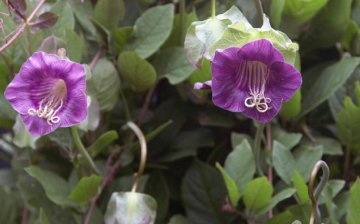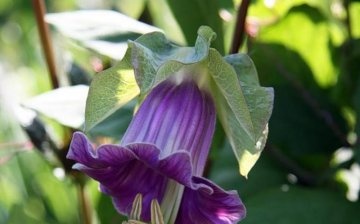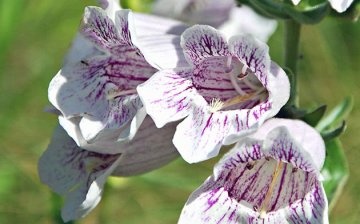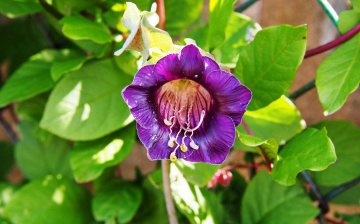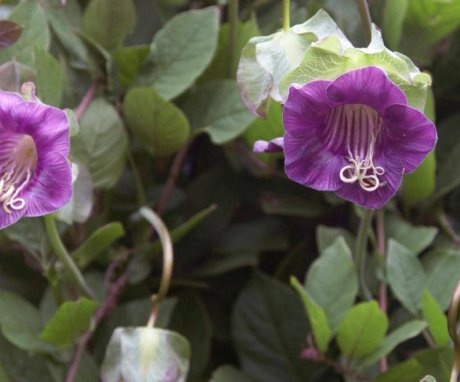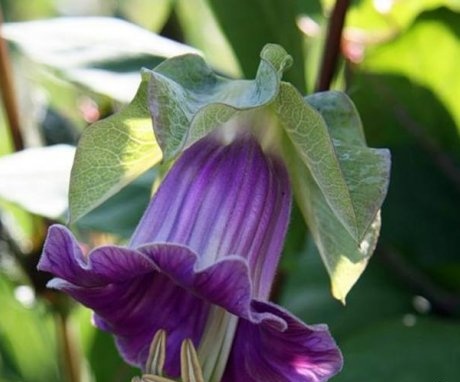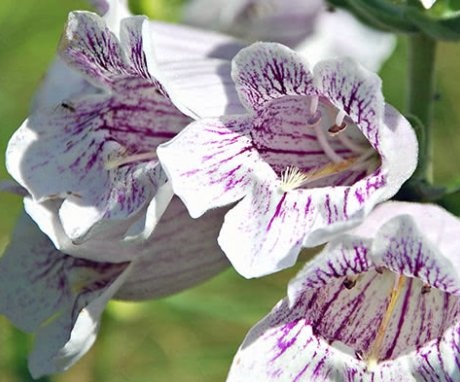Kobei flower: planting, care and wintering
The rainforests have given the inhabitants of latitudes with a temperate climate many species of plants, pleasing to the eye with magnificent bright colors. Among them there are many liana-like ones, which have found a place in the gardens. But growing them is associated with a number of difficulties.
The homeland of the perennial kobei creeper is the South American rainforest. Under natural conditions, the stems of the plant entangle neighboring trees, decorating them with large flowers and green leaves. No wonder kobei called a loach. This is one of the capricious plants that is difficult to maintain in our climate.
Content:
- Features of the structure of the kobei
- Terms and rules for planting in open ground
- Plant care recommendations
- Preparing for winter and wintering kobei
- Possible growing problems
- Kobei in landscape design
Features of the structure of the kobei
The tropical beauty of the kobei stands out for its long stems. In some species, they reach 6 meters. The shoots of kobei are decorated with openwork foliage and antennae, which serve to twine around the support. Therefore, the flower is used to create "living" walls in the garden. The fibrous roots of the plant grow rapidly, feeding on moisture and useful elements.
The flowers of the plant are similar in structure to bells, 8 centimeters in size.
From the middle pistils and stamens peep out like a flower decoration. The buds are located in the axils of the leaves on long pedicels. The color of the petals at the beginning of flowering is a delicate greenish or yellowish tone. But over time, their color changes to white or purple.
After the flowers have fallen, a box with small round seeds appears. In nature, it bursts, covering the ground around with seeds. This is how the kobea reproduces. The kobei thickets in the garden attract insects with their bright colors and musky aroma.
Terms and rules for planting in open ground
Kobei is grown in seedlings. Sowing begins in late February - early March. But before planting, preparatory work is carried out, which includes germination of seeds:
- First, the planting material needs to swell. You can soften the dense shell of the seeds by soaking them in a solution of an Epin-type growth stimulator. Suitable for softening and placing seeds in a damp cloth. If they do not germinate, then you can pierce the outer layer of the seed with a needle. The seeds will hatch faster in a warm place. It is important to moisten the napkin in a timely manner and not let the plantings grow moldy.
- The emerging sprouts are transferred to containers with nutritious and loose soil. The capacity should be an individual volume of 3-4 liters, because the flower is developing rapidly.
- Considering the need for support for the kobei, a stick is inserted into the ground next to the plant. You can replace it with twine, which is fixed at a height, and at the bottom they tie it to the stem of the bush.
- To enhance the growth of the plant bush, pinch the top of the main stem. Before transplanting into the garden, the flower is watered abundantly so that the soil in the pot is moist.
- Liana is transplanted into open ground in May - June, when the air temperature will reach 15-20 degrees Celsius. Even a slight cold snap is dangerous for creepers.
- A site for growing a flower is chosen open, illuminated, with a slight partial shade.The delicate stems of the liana are afraid of the wind, so they protect the kobei from it by placing it next to the fence or building.
The bushes of the plant grow rapidly. When planting seedlings, the distance between them should be within 1 meter. Planting pits are prepared for the bush, filling them with two parts of sod land, one part of peat and humus. It is better to plant a vine near a fence or support, which it will cover with a green flowering carpet.
Plant care recommendations
In the kobei garden, tropical conditions are created:
- Water the plant abundantly, as it does not tolerate dry air and soil. Spraying perennials should be frequent. It is better to carry out water procedures in the evening.
- It is better to cover the area around the shoot to retain moisture.
- Organic substances are needed from feeding the kobe, which it will take from the solution. mullein in a ratio of 1: 6. Mineral complexes are selected taking into account the importance of nitrogen, phosphorus and potassium in the development of vines. During flowering, the amount of nitrogen in the nutrition of the bush is reduced. Fertilize the plant once every 2 weeks.
- In order for the bush to grow better, long lashes are pinched.
- It is imperative to loosen the soil around the stems of the plant, which will provide an influx of moisture and air to the roots.
There are no difficulties in caring for a kobe, but without moisture and heat, it will begin to wither.
Preparing for winter and wintering kobei
It is impossible for a tropical vine to survive the low temperatures in winter in the garden. She is afraid even of a 10-degree air temperature in summer. Therefore, many gardeners plant kobei seeds every year. But you can help an adult plant prepare for winter, survive it and continue growing in the spring in the garden.
With the onset of autumn, when the nights are already getting colder, the kobei bush is cut off, leaving hemp of 10 centimeters. Having dug up the root of the plant, they transfer it to the cellar or basement, where the temperature will be comfortable for the vine - at least 10 degrees Celsius. Place the roots in a container with soil. The plant does not need light during the wintering period, since the kobea "hibernates".
During wintering, plants monitor the temperature and humidity in the room.
It is impossible for the soil in a container with roots to be overdried, but excessive moisture will lead to decay root system... In March, the container with the kobei is transferred to a warm and bright room, allowing the plant to wake up after winter. As soon as green shoots appear, they begin to care for the plant as usual. If the kobeya was properly prepared for winter and the wintering was successful, then the flower in the spring will look even more beautiful, magnificent and brighter.
Kobei is used for breeding at this time. Cuttings from young shoots are taken from uterine shoots. Then they are placed in a container filled with nutritious and loose soil. To speed up the appearance of roots in the shoots, cover the planting with a film on top. Every day the bushes are ventilated and watered. When warm, fine days come, young and adult specimens of the flower are planted in open ground.
Possible growing problems
Kobei will grow successfully in the garden, if appropriate conditions are created for it, they will be properly looked after:
- The yellowing of the foliage of the plant is a signal that the kobee lacks moisture.
- If the tips of the leaves become dry, then the liana is hot, it is better to shade the bush from the scorching rays of the sun.
- Root rot is determined by the wilting of the plant. Disease occurs due to increased moisture. Pathology can be prevented by regular loosening of the soil.
Of the pests are active in relation to the kobe spider mite and aphid... Both types of parasite are sucking pests. At the initial stage of infection, they can be dealt with with folk remedies. To do this, use an infusion of tobacco dust. They insist on taking a kilogram of tobacco for 5 liters of water. It is enough to boil the broth for an hour and take half a liter in a bucket of water, processing the bushes of the vines.The broth adheres better to the leaves of a diseased plant if you add laundry soap to it.
From the mite, pollination of the plant with colloidal sulfur powder is effective. Processing is carried out every 10 days. Treatment will save pests from pests more successfully insecticides... Problems with growing kobei are rare, only with improper care.
Kobei in landscape design
Blooming liana is used in garden design for a reason. She will make the area near the house or summer cottage exquisite, truly tropical:
- Kobei is most suitable for creating vertical figures. It can be polyhedra in the middle of a green lawn carpet. There is no better plant that could hide the flaws of garden structures, a fence.
- You can create a wall from the thickets of kobei, which will delimit the area into zones.
- And how beautiful a gazebo or a recreation area will look, fenced with a flowering and fragrant fence.
- It is easy to create arched walkways from liana-like bushes.
- Kobeya will become the backdrop for annual flowers in the flowerbed. It goes well with petunia, lobelia, verbena.
You can fantasize with a flowering perennial constantly, creating various figures, decorating the garden with unusual compositions.
More information can be found in the video:




